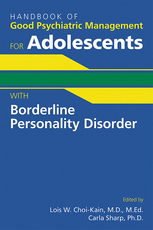Dimensional Models of Personality Disorders
Refining the Research Agenda for DSM-V
View Pricing
Description
DSM-IV and ICD-10 both diagnose personality disorders categorically, yet studies indicate that many patients meet criteria for an excessive number of diagnoses, raising the question of whether personality disorders are discrete conditions or rather distinctions along dimensions of general personality functioning. This collection of papers renews long-standing proposals for a dimensional model of personality disorder, describing alternative models, addressing questions about their clinical application and utility, and suggesting that future research seek to integrate such models within a common hierarchical structure.
With contributions by preeminent researchers in the field, Dimensional Models of Personality Disorders is drawn from a conference series convened by APA, WHO, and NIH in order to plan for the fifth edition of the DSM. The Nomenclature Work Group concluded that consideration should be given to basing part or all of DSM-V on dimensions rather than categories, and recommended that a dimensional model for personality disorders should serve as a basis for exploring dimensional approaches in other areas. Accordingly, the volume opens with a presentation of 18 proposals for dimensional models and proceeds with provocative contributions on a number of related issues ranging from hard science to clinical practice. Among the topics addressed are
- Behavioral and molecular genetic research supporting an etiologically informed dimensional classification of personality disorders
- The as-yet tenuous associations between dimensional trait measures of personality as contained in the models of Cloninger, Depue, and Siever-Davis, and specific neurobiological measures, as examined in neurotransmitter research
- Potential links between childhood and adolescent temperament and personality dimensions and adult personality psychopathology
- Studies examining the covariation of personality dimensions across cultures
- The continuity of Axis I and Axis II disorders and a proposed hierarchical structure of mental disorders that integrates the psychopathology of Axis I disorders with specific personality traits
- The dual challenges of coverage and cutoffs that must be addressed if dimensional models are to be considered viable alternatives to the existing categorical diagnostic system
Although the editors acknowledge that concerns are certain to be raised regarding conversion to a dimensional classification—such as the disruption to clinical practice by a radical shift in diagnosing personality disorder—these papers make a strong case for opening the field to alternative ways of enhancing clinical utility and improving the validity of basic classification concepts. Together, they offer stimulating insight into how we approach personality disorders, with the hope of encouraging a new model of diagnosis for DSM-V.
Contents
- Contributors
- Disclosure statement
- Foreword
- Preface
- Introduction
- Chapter 1. Alternative dimensional models of personality disorder: finding a common ground
- Chapter 2. Commentary on Widiger and Simonsen: toward a consensus personality trait structure
- Chapter 3. Commentary on Widiger and Simonsen: working out a dimensional framework
- Chapter 4. Commentary on Widiger and Simonsen: from ICD-10 and DSM-IV to ICD-11 and DSM-V
- Chapter 5. Behavioral and molecular genetic contributions to a dimensional classification of personality disorder
- Chapter 6. Commentary on Livesley: genetic contributions to a dimensional classification: problems and pitfalls
- Chapter 7. Neurobiological dimensional models of personality: a review of three models
- Chapter 8. Commentary on Paris: personality as a dynamic psychobiological system
- Chapter 9. Commentary on Paris: the problem of severity in personality disorder classification
- Chapter 10. Temperament and personality as broad-spectrum antecedents of psychopathology in childhood and adolescence
- Chapter 11. Commentary on Mervielde et al.: toward a developmental perspective on personality disorders
- Chapter 12. Personality dimensions across cultures
- Chapter 13. Commentary on Allik: the lexical approach to the study of personality structure
- Chapter 14. Commentary on Allik: a historical perspective on personality disorder
- Chapter 15. Commentary on Allik: cross-cultural diagnosis of personality disorder
- Chapter 16. Continuity of Axes I and II: toward a unified model of personality, personality disorders, and clinical disorders
- Chapter 17. Commentary on Krueger: what to do with the old distinctions
- Chapter 18. Commentary on Krueger: traits versus types in the classification of personality pathology
- Chapter 19. Dimensional models: coverage and cutoffs
- Chapter 20. Commentary on Trull: drizzling on the 5
About the Authors
Thomas A. Widiger, Ph.D., is professor in the Department of Psychology at the University of Kentucky in Lexington, Kentucky.
Erik Simonsen, M.D., is Chief Psychiatrist at Roskilde County Hospital Fjorden and Medical Director at the Institute of Personality Theory and Psychopathology in Roskilde, Denmark.
Paul J. Sirovatka, M.S., is Associate Director for Research at the American Psychiatric Institute for Research and Education and the Division of Research at the American Psychiatric Association in Washington, D.C.
Darrel A. Regier, M.D., M.P.H., is Executive Director of the American Psychiatric Institute for Research and Education and Director of the Division of Research at the American Psychiatric Association in Washington, D.C.
Related Products
Carousel Control - items will scroll by tabbing through them, otherwise arrows can be used to scroll one item at a time








